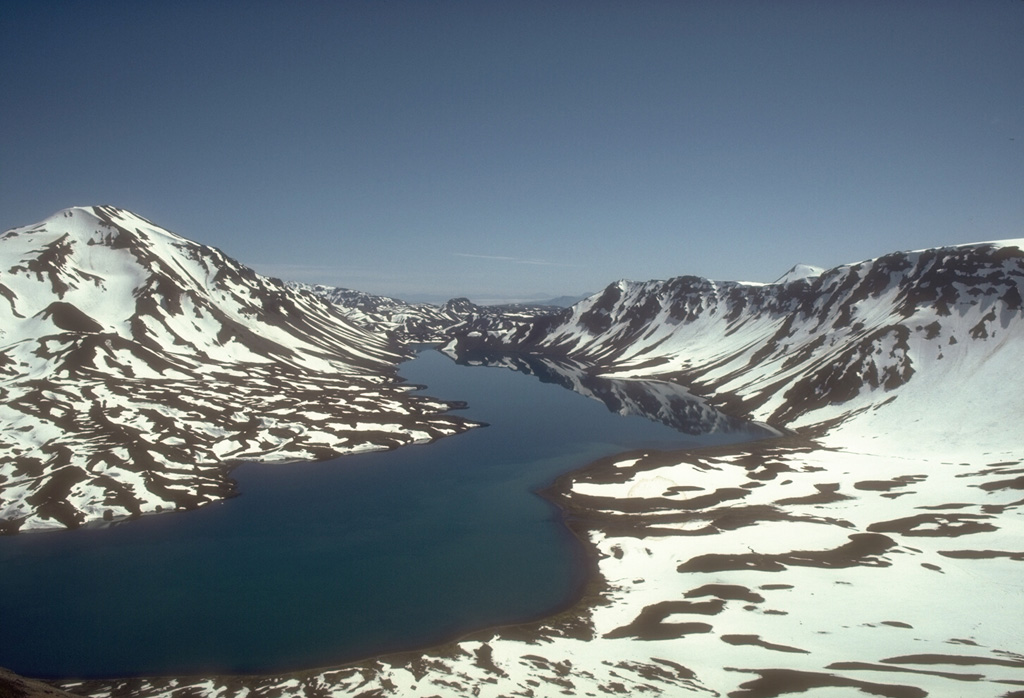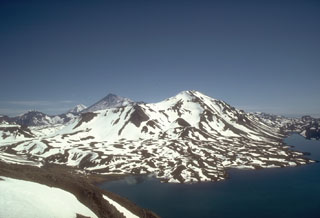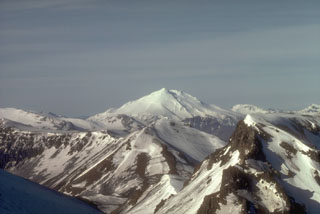

Fumarolic activity
On 14 July at about 2100, Richard Mack observed and photographed a white plume that had risen 350-500 m from the SW side of the summit crater of Mt. Hague, near the E margin of Emmons Lake Caldera. A series of pulses slowly diminished in size until sunset at about 2200. Traces of material trailed SSW from the top of the plume.
Mack stated that he had not seen such activity during his 57 years on the Alaska Peninsula. However, during fieldwork in 1946, Kennedy and Waldron (1955) observed six large fumaroles and many other small ones in a steep gully on the SW side of Mt. Hague, at altitudes of ~975-1,150 m. They did not give plume heights, but reported clouds of SO2 and steam rising from the major vents, with a locomotive-like noise that was audible ½ km away. The volume of sulfur fumes prevented the geologists from approaching nearer than roughly 100 m from the vents. Sulfur odors were strong many kilometers downwind. Sulfur cones ~1 m high had developed around the vents and extensive deposits of native sulfur were found in the gully. Miller (in Wood and Kienle, 1990) also reported a large fumarolic area on the S side of Mt. Hague.
Miller notes two caldera-forming eruptions at Emmons Lake, the second, in late Wisconsin time, depositing non-welded rhyolitic ashflow tuffs >30 km from the caldera rim. Post-caldera activity, dominantly basaltic, generated lava flows from several small cinder cones and vents. Some young Holocene flows advanced through the breach in the S caldera wall to within 1 km of the ocean.
References. Kennedy, G.C. and Waldron, H.H., 1955, Geology of Pavlof Volcano and Vicinity, Alaska: USGS Bulletin 1028A, p. 1-20.
Miller, T.P., 1990, Emmons and Hague, in Wood, C.A. and Kienle, J., eds., 1990, Volcanoes of North America: United States and Canada: Cambridge University Press, p. 52-53.
Information Contacts: J. Reeder, ADGGS.
The Global Volcanism Program has no Weekly Reports available for Emmons Lake Volcanic Center.
Reports are organized chronologically and indexed below by Month/Year (Publication Volume:Number), and include a one-line summary. Click on the index link or scroll down to read the reports.
Fumarolic activity
On 14 July at about 2100, Richard Mack observed and photographed a white plume that had risen 350-500 m from the SW side of the summit crater of Mt. Hague, near the E margin of Emmons Lake Caldera. A series of pulses slowly diminished in size until sunset at about 2200. Traces of material trailed SSW from the top of the plume.
Mack stated that he had not seen such activity during his 57 years on the Alaska Peninsula. However, during fieldwork in 1946, Kennedy and Waldron (1955) observed six large fumaroles and many other small ones in a steep gully on the SW side of Mt. Hague, at altitudes of ~975-1,150 m. They did not give plume heights, but reported clouds of SO2 and steam rising from the major vents, with a locomotive-like noise that was audible ½ km away. The volume of sulfur fumes prevented the geologists from approaching nearer than roughly 100 m from the vents. Sulfur odors were strong many kilometers downwind. Sulfur cones ~1 m high had developed around the vents and extensive deposits of native sulfur were found in the gully. Miller (in Wood and Kienle, 1990) also reported a large fumarolic area on the S side of Mt. Hague.
Miller notes two caldera-forming eruptions at Emmons Lake, the second, in late Wisconsin time, depositing non-welded rhyolitic ashflow tuffs >30 km from the caldera rim. Post-caldera activity, dominantly basaltic, generated lava flows from several small cinder cones and vents. Some young Holocene flows advanced through the breach in the S caldera wall to within 1 km of the ocean.
References. Kennedy, G.C. and Waldron, H.H., 1955, Geology of Pavlof Volcano and Vicinity, Alaska: USGS Bulletin 1028A, p. 1-20.
Miller, T.P., 1990, Emmons and Hague, in Wood, C.A. and Kienle, J., eds., 1990, Volcanoes of North America: United States and Canada: Cambridge University Press, p. 52-53.
Information Contacts: J. Reeder, ADGGS.
|
|
||||||||||||||||||||||||||
The Global Volcanism Program is not aware of any Holocene eruptions from Emmons Lake Volcanic Center. If this volcano has had large eruptions (VEI >= 4) prior to 12,000 years ago, information might be found on the Emmons Lake Volcanic Center page in the LaMEVE (Large Magnitude Explosive Volcanic Eruptions) database, a part of the Volcano Global Risk Identification and Analysis Project (VOGRIPA).
This compilation of synonyms and subsidiary features may not be comprehensive. Features are organized into four major categories: Cones, Craters, Domes, and Thermal Features. Synonyms of features appear indented below the primary name. In some cases additional feature type, elevation, or location details are provided.
Cones |
||||
| Feature Name | Feature Type | Elevation | Latitude | Longitude |
| Double Crater | Stratovolcano | 1343 m | 55° 23' 29.00" N | 161° 56' 47.00" W |
| Emmons, Mount | Stratovolcano | 1312 m | 55° 20' 28.00" N | 162° 4' 23.00" W |
| Hague, Mount | Stratovolcano | 1534 m | 55° 22' 41.00" N | 161° 58' 36.00" W |
Craters |
||||
| Feature Name | Feature Type | Elevation | Latitude | Longitude |
| Emmons Lake | Caldera | 344 m | 55° 21' 30.00" N | 162° 3' 15.00" W |
 Emmons Lake is a 11 x 18 km caldera and is one of the largest calderas in the Aleutian arc. The caldera formed during two large Quaternary eruptions that produced welded tuffs extending to both the Bering Sea and Pacific Ocean. This 1988 view from the SW shows Emmons Lake, the southern caldera wall (right), and Mount Emmons, a post-caldera volcano (left). The post-caldera Mount Emmons, Double Crater, and Mount Hague cones are oriented along the same NE trend as the elongate caldera.
Emmons Lake is a 11 x 18 km caldera and is one of the largest calderas in the Aleutian arc. The caldera formed during two large Quaternary eruptions that produced welded tuffs extending to both the Bering Sea and Pacific Ocean. This 1988 view from the SW shows Emmons Lake, the southern caldera wall (right), and Mount Emmons, a post-caldera volcano (left). The post-caldera Mount Emmons, Double Crater, and Mount Hague cones are oriented along the same NE trend as the elongate caldera. Mount Emmons is along the SW side of the 11 x 18 km Emmons Lake caldera. Youthful lava flows form the irregular shoreline of Emmons Lake in the foreground. The high peaks in the background (left center) are Pavlof just beyond the NE rim of the caldera, and Pavlof Sister.
Mount Emmons is along the SW side of the 11 x 18 km Emmons Lake caldera. Youthful lava flows form the irregular shoreline of Emmons Lake in the foreground. The high peaks in the background (left center) are Pavlof just beyond the NE rim of the caldera, and Pavlof Sister. Mount Dutton, seen here from the NE with the wall of Emmons Lake caldera in the foreground, is located near the tip of the Alaska Peninsula. Successive lava domes form the summit; collapse events during the Holocene produced debris avalanches that traveled to the west and also reached Belkofski Bay to the south.
Mount Dutton, seen here from the NE with the wall of Emmons Lake caldera in the foreground, is located near the tip of the Alaska Peninsula. Successive lava domes form the summit; collapse events during the Holocene produced debris avalanches that traveled to the west and also reached Belkofski Bay to the south.The following 8 samples associated with this volcano can be found in the Smithsonian's NMNH Department of Mineral Sciences collections, and may be availble for research (contact the Rock and Ore Collections Manager). Catalog number links will open a window with more information.
| Catalog Number | Sample Description | Lava Source | Collection Date |
|---|---|---|---|
| NMNH 117233-168 | Pumice | Emmons | -- |
| NMNH 117233-169 | Tuff | Emmons | -- |
| NMNH 117233-170 | Pumice | Emmons | -- |
| NMNH 117233-171 | Pumice | Emmons | -- |
| NMNH 117233-172 | Tuff | Emmons | -- |
| NMNH 117233-173 | Pumice | Emmons | -- |
| NMNH 117233-180 | Pumice | Emmons | -- |
| NMNH 117233-184 | Pumice | Emmons | -- |
| Alaska Volcano Observatory (Link to Emmons Lake Volcanic Center) | The Alaska Volcano Observatory (AVO) is a joint program of the U.S. Geological Survey (USGS), the Geophysical Institute of the University of Alaska Fairbanks (UAFGI), and the State of Alaska Division of Geological and Geophysical Surveys (ADGGS). AVO was formed in 1988, and uses federal, state, and university resources to monitor and study Alaska's hazardous volcanoes, to predict and record eruptive activity, and to mitigate volcanic hazards to life and property. |
| Copernicus Browser | The Copernicus Browser replaced the Sentinel Hub Playground browser in 2023, to provide access to Earth observation archives from the Copernicus Data Space Ecosystem, the main distribution platform for data from the EU Copernicus missions. |
| MIROVA | Middle InfraRed Observation of Volcanic Activity (MIROVA) is a near real time volcanic hot-spot detection system based on the analysis of MODIS (Moderate Resolution Imaging Spectroradiometer) data. In particular, MIROVA uses the Middle InfraRed Radiation (MIR), measured over target volcanoes, in order to detect, locate and measure the heat radiation sourced from volcanic activity. |
| MODVOLC Thermal Alerts | Using infrared satellite Moderate Resolution Imaging Spectroradiometer (MODIS) data, scientists at the Hawai'i Institute of Geophysics and Planetology, University of Hawai'i, developed an automated system called MODVOLC to map thermal hot-spots in near real time. For each MODIS image, the algorithm automatically scans each 1 km pixel within it to check for high-temperature hot-spots. When one is found the date, time, location, and intensity are recorded. MODIS looks at every square km of the Earth every 48 hours, once during the day and once during the night, and the presence of two MODIS sensors in space allows at least four hot-spot observations every two days. Each day updated global maps are compiled to display the locations of all hot spots detected in the previous 24 hours. There is a drop-down list with volcano names which allow users to 'zoom-in' and examine the distribution of hot-spots at a variety of spatial scales. |
|
WOVOdat
Single Volcano View Temporal Evolution of Unrest Side by Side Volcanoes |
WOVOdat is a database of volcanic unrest; instrumentally and visually recorded changes in seismicity, ground deformation, gas emission, and other parameters from their normal baselines. It is sponsored by the World Organization of Volcano Observatories (WOVO) and presently hosted at the Earth Observatory of Singapore.
GVMID Data on Volcano Monitoring Infrastructure The Global Volcano Monitoring Infrastructure Database GVMID, is aimed at documenting and improving capabilities of volcano monitoring from the ground and space. GVMID should provide a snapshot and baseline view of the techniques and instrumentation that are in place at various volcanoes, which can be use by volcano observatories as reference to setup new monitoring system or improving networks at a specific volcano. These data will allow identification of what monitoring gaps exist, which can be then targeted by remote sensing infrastructure and future instrument deployments. |
| Volcanic Hazard Maps | The IAVCEI Commission on Volcanic Hazards and Risk has a Volcanic Hazard Maps database designed to serve as a resource for hazard mappers (or other interested parties) to explore how common issues in hazard map development have been addressed at different volcanoes, in different countries, for different hazards, and for different intended audiences. In addition to the comprehensive, searchable Volcanic Hazard Maps Database, this website contains information about diversity of volcanic hazard maps, illustrated using examples from the database. This site is for educational purposes related to volcanic hazard maps. Hazard maps found on this website should not be used for emergency purposes. For the most recent, official hazard map for a particular volcano, please seek out the proper institutional authorities on the matter. |
| IRIS seismic stations/networks | Incorporated Research Institutions for Seismology (IRIS) Data Services map showing the location of seismic stations from all available networks (permanent or temporary) within a radius of 0.18° (about 20 km at mid-latitudes) from the given location of Emmons Lake Volcanic Center. Users can customize a variety of filters and options in the left panel. Note that if there are no stations are known the map will default to show the entire world with a "No data matched request" error notice. |
| UNAVCO GPS/GNSS stations | Geodetic Data Services map from UNAVCO showing the location of GPS/GNSS stations from all available networks (permanent or temporary) within a radius of 20 km from the given location of Emmons Lake Volcanic Center. Users can customize the data search based on station or network names, location, and time window. Requires Adobe Flash Player. |
| DECADE Data | The DECADE portal, still in the developmental stage, serves as an example of the proposed interoperability between The Smithsonian Institution's Global Volcanism Program, the Mapping Gas Emissions (MaGa) Database, and the EarthChem Geochemical Portal. The Deep Earth Carbon Degassing (DECADE) initiative seeks to use new and established technologies to determine accurate global fluxes of volcanic CO2 to the atmosphere, but installing CO2 monitoring networks on 20 of the world's 150 most actively degassing volcanoes. The group uses related laboratory-based studies (direct gas sampling and analysis, melt inclusions) to provide new data for direct degassing of deep earth carbon to the atmosphere. |
| Large Eruptions of Emmons Lake Volcanic Center | Information about large Quaternary eruptions (VEI >= 4) is cataloged in the Large Magnitude Explosive Volcanic Eruptions (LaMEVE) database of the Volcano Global Risk Identification and Analysis Project (VOGRIPA). |
| EarthChem | EarthChem develops and maintains databases, software, and services that support the preservation, discovery, access and analysis of geochemical data, and facilitate their integration with the broad array of other available earth science parameters. EarthChem is operated by a joint team of disciplinary scientists, data scientists, data managers and information technology developers who are part of the NSF-funded data facility Integrated Earth Data Applications (IEDA). IEDA is a collaborative effort of EarthChem and the Marine Geoscience Data System (MGDS). |